Business Model Evolution and Strategy
VerifiedAdded on 2020/04/29
|10
|3066
|47
AI Summary
This assignment delves into the dynamic nature of business models and their evolution over time. It analyzes the concept of strategic agility as a key factor in adapting to changing market conditions. The assignment requires students to understand core theories like Work System Theory and apply them to real-world business scenarios. It also emphasizes the importance of negotiation and collaboration in shaping successful business strategies.
Contribute Materials
Your contribution can guide someone’s learning journey. Share your
documents today.
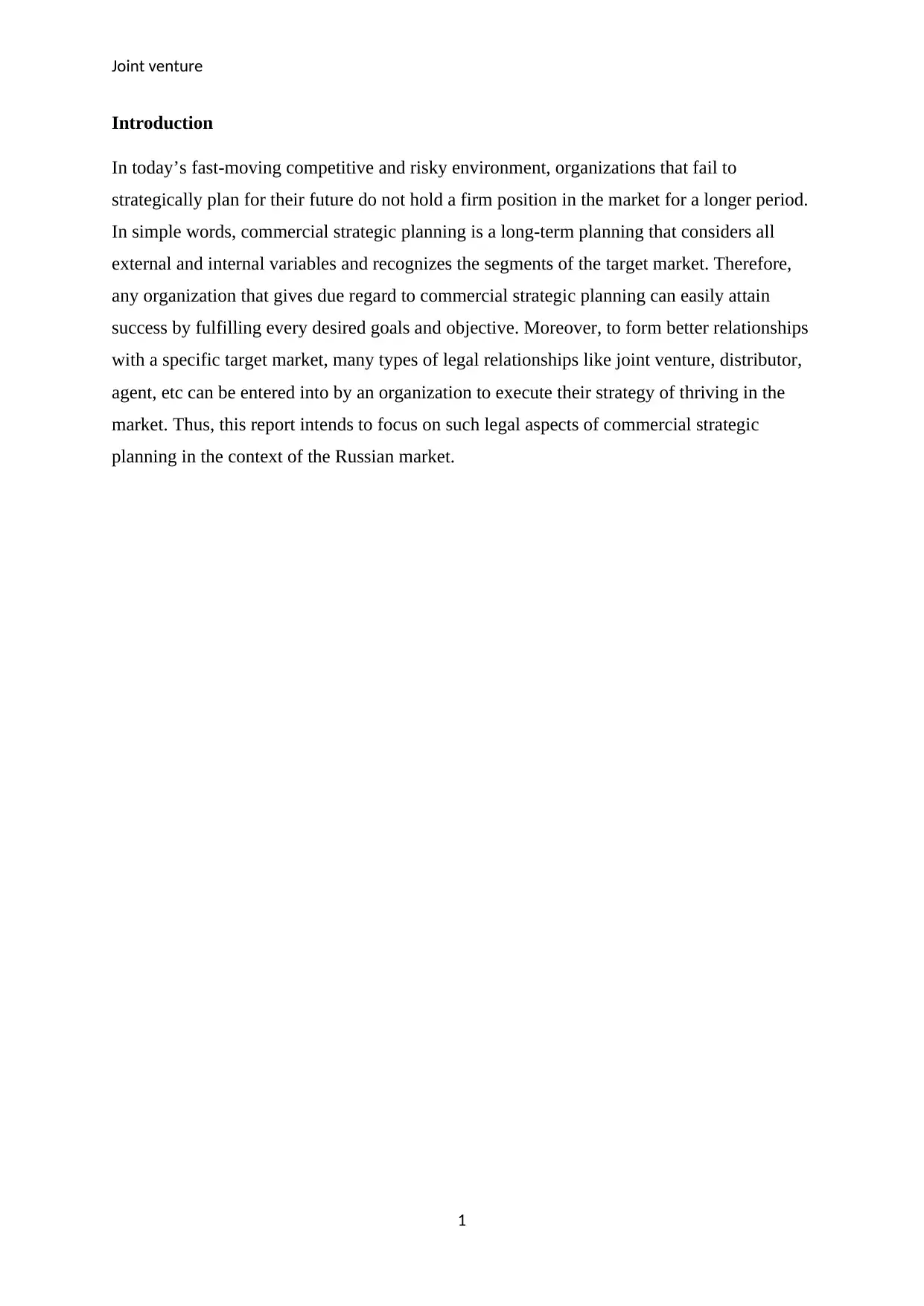
Joint venture
Introduction
In today’s fast-moving competitive and risky environment, organizations that fail to
strategically plan for their future do not hold a firm position in the market for a longer period.
In simple words, commercial strategic planning is a long-term planning that considers all
external and internal variables and recognizes the segments of the target market. Therefore,
any organization that gives due regard to commercial strategic planning can easily attain
success by fulfilling every desired goals and objective. Moreover, to form better relationships
with a specific target market, many types of legal relationships like joint venture, distributor,
agent, etc can be entered into by an organization to execute their strategy of thriving in the
market. Thus, this report intends to focus on such legal aspects of commercial strategic
planning in the context of the Russian market.
1
Introduction
In today’s fast-moving competitive and risky environment, organizations that fail to
strategically plan for their future do not hold a firm position in the market for a longer period.
In simple words, commercial strategic planning is a long-term planning that considers all
external and internal variables and recognizes the segments of the target market. Therefore,
any organization that gives due regard to commercial strategic planning can easily attain
success by fulfilling every desired goals and objective. Moreover, to form better relationships
with a specific target market, many types of legal relationships like joint venture, distributor,
agent, etc can be entered into by an organization to execute their strategy of thriving in the
market. Thus, this report intends to focus on such legal aspects of commercial strategic
planning in the context of the Russian market.
1
Secure Best Marks with AI Grader
Need help grading? Try our AI Grader for instant feedback on your assignments.
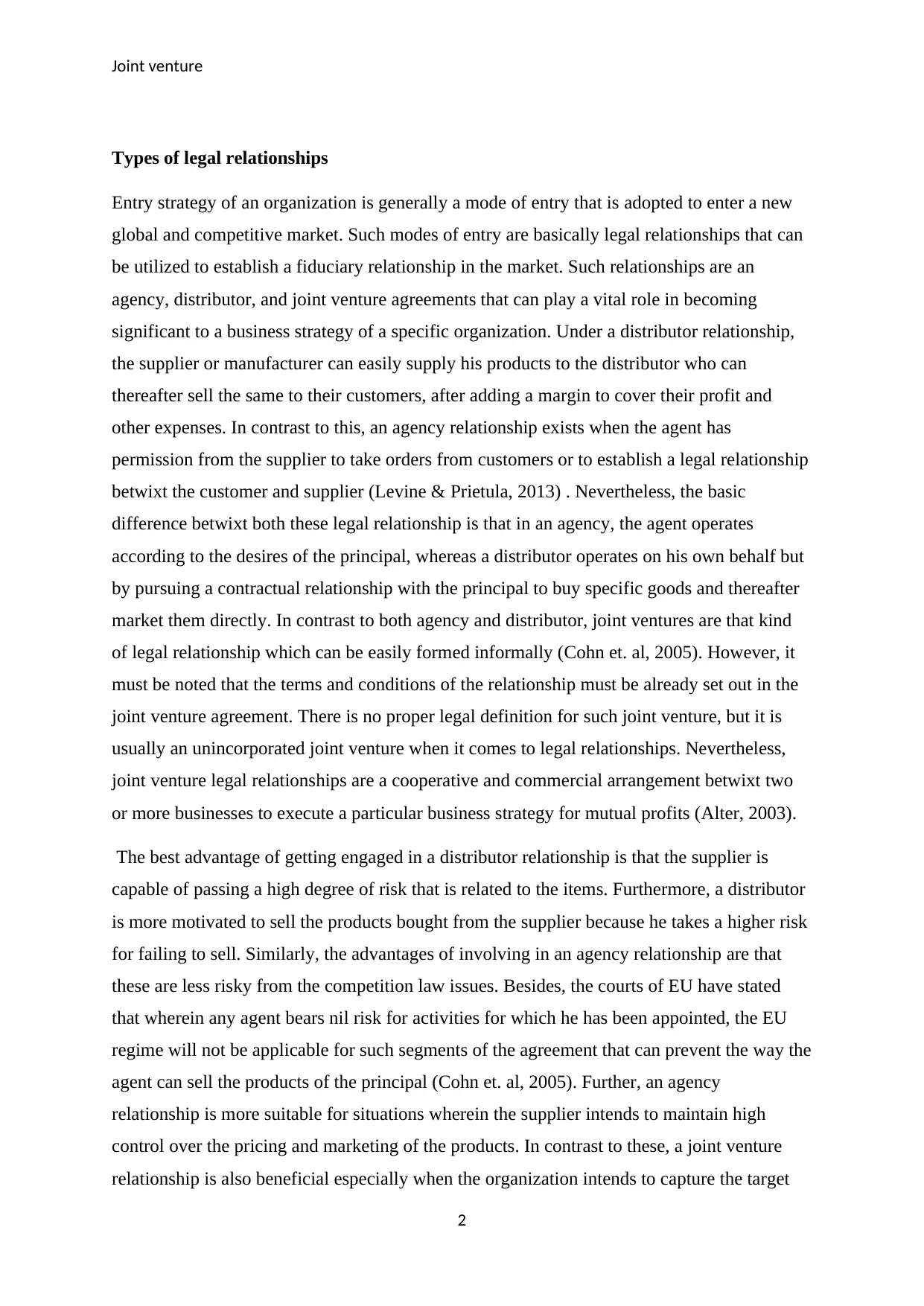
Joint venture
Types of legal relationships
Entry strategy of an organization is generally a mode of entry that is adopted to enter a new
global and competitive market. Such modes of entry are basically legal relationships that can
be utilized to establish a fiduciary relationship in the market. Such relationships are an
agency, distributor, and joint venture agreements that can play a vital role in becoming
significant to a business strategy of a specific organization. Under a distributor relationship,
the supplier or manufacturer can easily supply his products to the distributor who can
thereafter sell the same to their customers, after adding a margin to cover their profit and
other expenses. In contrast to this, an agency relationship exists when the agent has
permission from the supplier to take orders from customers or to establish a legal relationship
betwixt the customer and supplier (Levine & Prietula, 2013) . Nevertheless, the basic
difference betwixt both these legal relationship is that in an agency, the agent operates
according to the desires of the principal, whereas a distributor operates on his own behalf but
by pursuing a contractual relationship with the principal to buy specific goods and thereafter
market them directly. In contrast to both agency and distributor, joint ventures are that kind
of legal relationship which can be easily formed informally (Cohn et. al, 2005). However, it
must be noted that the terms and conditions of the relationship must be already set out in the
joint venture agreement. There is no proper legal definition for such joint venture, but it is
usually an unincorporated joint venture when it comes to legal relationships. Nevertheless,
joint venture legal relationships are a cooperative and commercial arrangement betwixt two
or more businesses to execute a particular business strategy for mutual profits (Alter, 2003).
The best advantage of getting engaged in a distributor relationship is that the supplier is
capable of passing a high degree of risk that is related to the items. Furthermore, a distributor
is more motivated to sell the products bought from the supplier because he takes a higher risk
for failing to sell. Similarly, the advantages of involving in an agency relationship are that
these are less risky from the competition law issues. Besides, the courts of EU have stated
that wherein any agent bears nil risk for activities for which he has been appointed, the EU
regime will not be applicable for such segments of the agreement that can prevent the way the
agent can sell the products of the principal (Cohn et. al, 2005). Further, an agency
relationship is more suitable for situations wherein the supplier intends to maintain high
control over the pricing and marketing of the products. In contrast to these, a joint venture
relationship is also beneficial especially when the organization intends to capture the target
2
Types of legal relationships
Entry strategy of an organization is generally a mode of entry that is adopted to enter a new
global and competitive market. Such modes of entry are basically legal relationships that can
be utilized to establish a fiduciary relationship in the market. Such relationships are an
agency, distributor, and joint venture agreements that can play a vital role in becoming
significant to a business strategy of a specific organization. Under a distributor relationship,
the supplier or manufacturer can easily supply his products to the distributor who can
thereafter sell the same to their customers, after adding a margin to cover their profit and
other expenses. In contrast to this, an agency relationship exists when the agent has
permission from the supplier to take orders from customers or to establish a legal relationship
betwixt the customer and supplier (Levine & Prietula, 2013) . Nevertheless, the basic
difference betwixt both these legal relationship is that in an agency, the agent operates
according to the desires of the principal, whereas a distributor operates on his own behalf but
by pursuing a contractual relationship with the principal to buy specific goods and thereafter
market them directly. In contrast to both agency and distributor, joint ventures are that kind
of legal relationship which can be easily formed informally (Cohn et. al, 2005). However, it
must be noted that the terms and conditions of the relationship must be already set out in the
joint venture agreement. There is no proper legal definition for such joint venture, but it is
usually an unincorporated joint venture when it comes to legal relationships. Nevertheless,
joint venture legal relationships are a cooperative and commercial arrangement betwixt two
or more businesses to execute a particular business strategy for mutual profits (Alter, 2003).
The best advantage of getting engaged in a distributor relationship is that the supplier is
capable of passing a high degree of risk that is related to the items. Furthermore, a distributor
is more motivated to sell the products bought from the supplier because he takes a higher risk
for failing to sell. Similarly, the advantages of involving in an agency relationship are that
these are less risky from the competition law issues. Besides, the courts of EU have stated
that wherein any agent bears nil risk for activities for which he has been appointed, the EU
regime will not be applicable for such segments of the agreement that can prevent the way the
agent can sell the products of the principal (Cohn et. al, 2005). Further, an agency
relationship is more suitable for situations wherein the supplier intends to maintain high
control over the pricing and marketing of the products. In contrast to these, a joint venture
relationship is also beneficial especially when the organization intends to capture the target
2
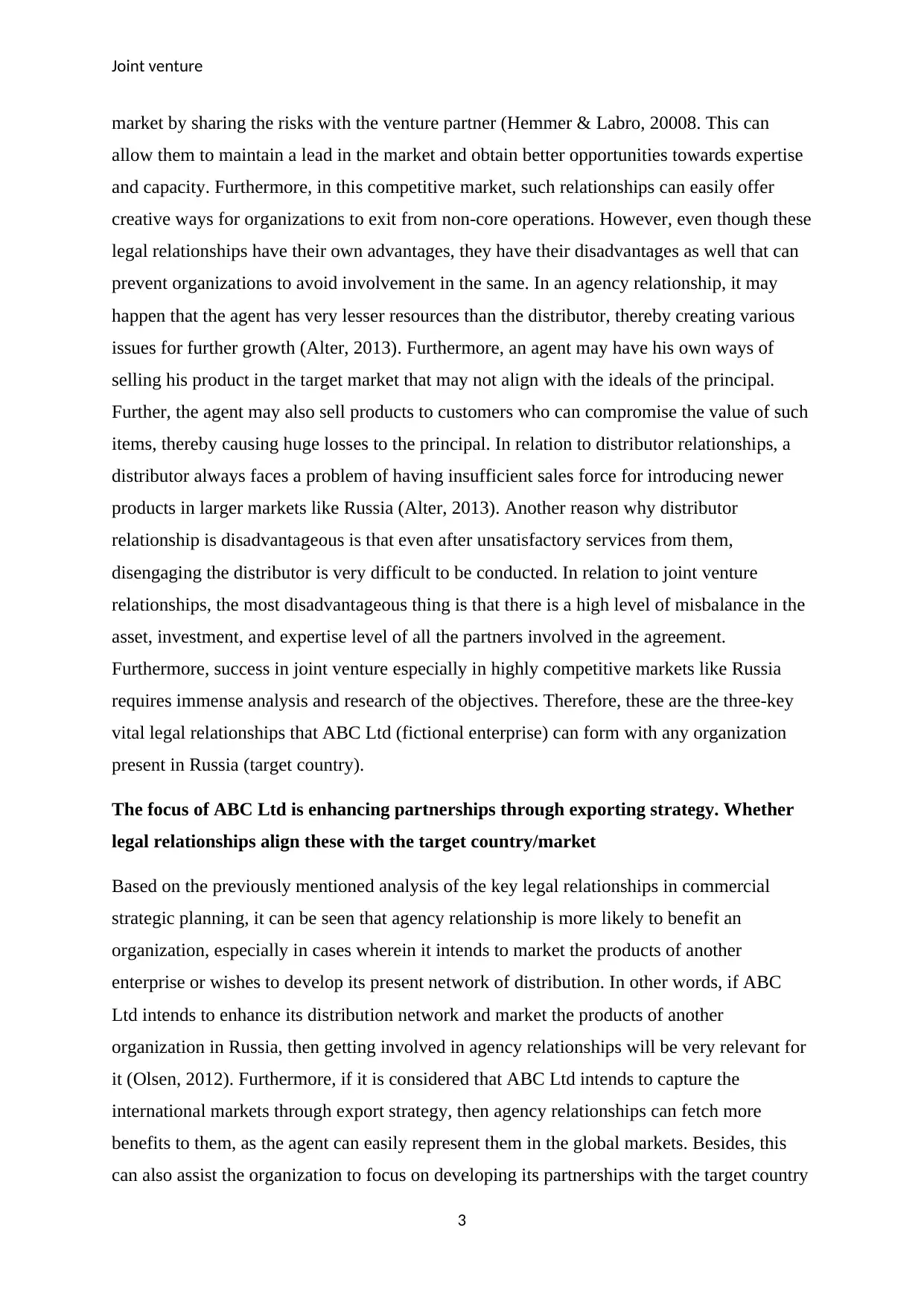
Joint venture
market by sharing the risks with the venture partner (Hemmer & Labro, 20008. This can
allow them to maintain a lead in the market and obtain better opportunities towards expertise
and capacity. Furthermore, in this competitive market, such relationships can easily offer
creative ways for organizations to exit from non-core operations. However, even though these
legal relationships have their own advantages, they have their disadvantages as well that can
prevent organizations to avoid involvement in the same. In an agency relationship, it may
happen that the agent has very lesser resources than the distributor, thereby creating various
issues for further growth (Alter, 2013). Furthermore, an agent may have his own ways of
selling his product in the target market that may not align with the ideals of the principal.
Further, the agent may also sell products to customers who can compromise the value of such
items, thereby causing huge losses to the principal. In relation to distributor relationships, a
distributor always faces a problem of having insufficient sales force for introducing newer
products in larger markets like Russia (Alter, 2013). Another reason why distributor
relationship is disadvantageous is that even after unsatisfactory services from them,
disengaging the distributor is very difficult to be conducted. In relation to joint venture
relationships, the most disadvantageous thing is that there is a high level of misbalance in the
asset, investment, and expertise level of all the partners involved in the agreement.
Furthermore, success in joint venture especially in highly competitive markets like Russia
requires immense analysis and research of the objectives. Therefore, these are the three-key
vital legal relationships that ABC Ltd (fictional enterprise) can form with any organization
present in Russia (target country).
The focus of ABC Ltd is enhancing partnerships through exporting strategy. Whether
legal relationships align these with the target country/market
Based on the previously mentioned analysis of the key legal relationships in commercial
strategic planning, it can be seen that agency relationship is more likely to benefit an
organization, especially in cases wherein it intends to market the products of another
enterprise or wishes to develop its present network of distribution. In other words, if ABC
Ltd intends to enhance its distribution network and market the products of another
organization in Russia, then getting involved in agency relationships will be very relevant for
it (Olsen, 2012). Furthermore, if it is considered that ABC Ltd intends to capture the
international markets through export strategy, then agency relationships can fetch more
benefits to them, as the agent can easily represent them in the global markets. Besides, this
can also assist the organization to focus on developing its partnerships with the target country
3
market by sharing the risks with the venture partner (Hemmer & Labro, 20008. This can
allow them to maintain a lead in the market and obtain better opportunities towards expertise
and capacity. Furthermore, in this competitive market, such relationships can easily offer
creative ways for organizations to exit from non-core operations. However, even though these
legal relationships have their own advantages, they have their disadvantages as well that can
prevent organizations to avoid involvement in the same. In an agency relationship, it may
happen that the agent has very lesser resources than the distributor, thereby creating various
issues for further growth (Alter, 2013). Furthermore, an agent may have his own ways of
selling his product in the target market that may not align with the ideals of the principal.
Further, the agent may also sell products to customers who can compromise the value of such
items, thereby causing huge losses to the principal. In relation to distributor relationships, a
distributor always faces a problem of having insufficient sales force for introducing newer
products in larger markets like Russia (Alter, 2013). Another reason why distributor
relationship is disadvantageous is that even after unsatisfactory services from them,
disengaging the distributor is very difficult to be conducted. In relation to joint venture
relationships, the most disadvantageous thing is that there is a high level of misbalance in the
asset, investment, and expertise level of all the partners involved in the agreement.
Furthermore, success in joint venture especially in highly competitive markets like Russia
requires immense analysis and research of the objectives. Therefore, these are the three-key
vital legal relationships that ABC Ltd (fictional enterprise) can form with any organization
present in Russia (target country).
The focus of ABC Ltd is enhancing partnerships through exporting strategy. Whether
legal relationships align these with the target country/market
Based on the previously mentioned analysis of the key legal relationships in commercial
strategic planning, it can be seen that agency relationship is more likely to benefit an
organization, especially in cases wherein it intends to market the products of another
enterprise or wishes to develop its present network of distribution. In other words, if ABC
Ltd intends to enhance its distribution network and market the products of another
organization in Russia, then getting involved in agency relationships will be very relevant for
it (Olsen, 2012). Furthermore, if it is considered that ABC Ltd intends to capture the
international markets through export strategy, then agency relationships can fetch more
benefits to them, as the agent can easily represent them in the global markets. Besides, this
can also assist the organization to focus on developing its partnerships with the target country
3
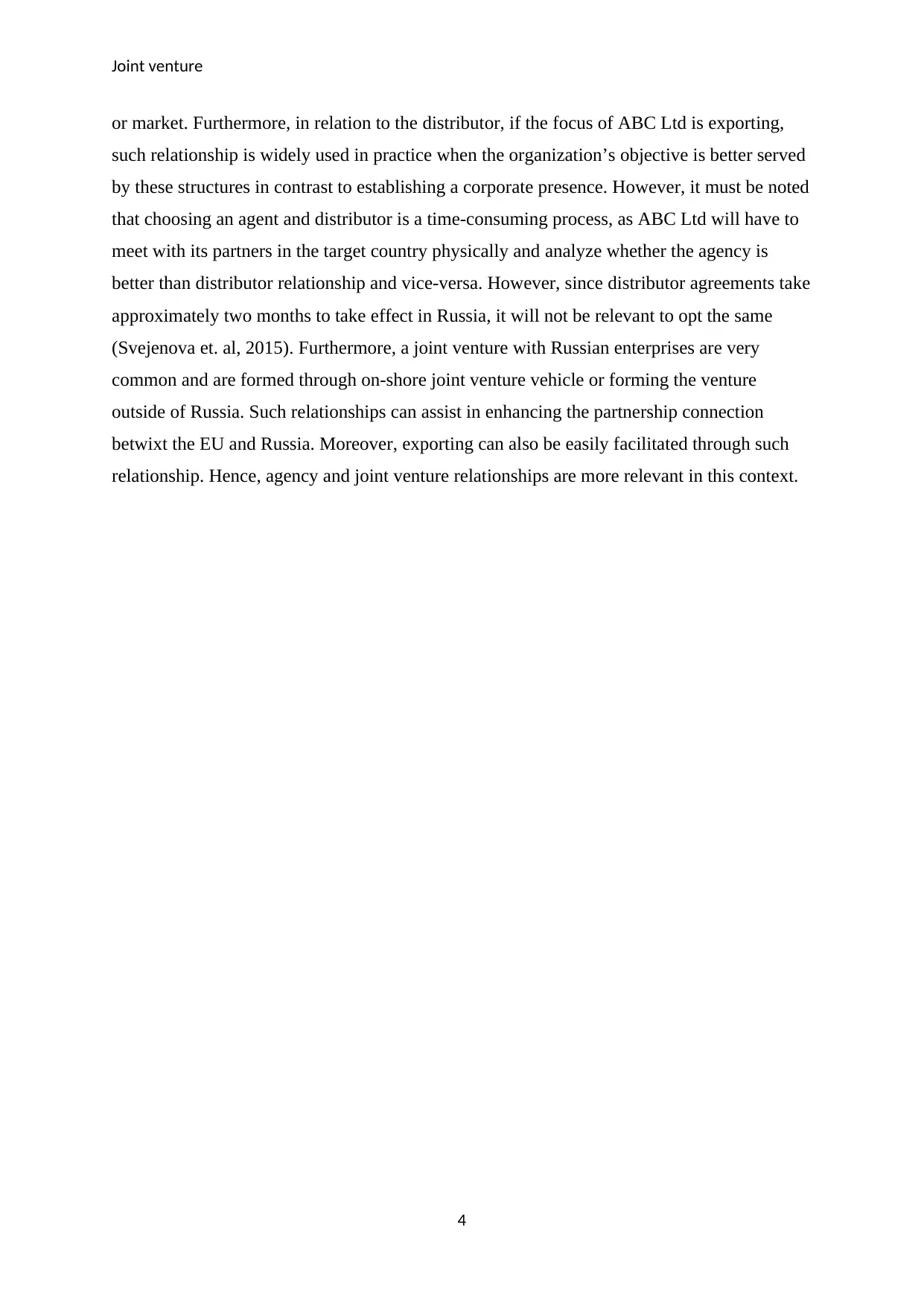
Joint venture
or market. Furthermore, in relation to the distributor, if the focus of ABC Ltd is exporting,
such relationship is widely used in practice when the organization’s objective is better served
by these structures in contrast to establishing a corporate presence. However, it must be noted
that choosing an agent and distributor is a time-consuming process, as ABC Ltd will have to
meet with its partners in the target country physically and analyze whether the agency is
better than distributor relationship and vice-versa. However, since distributor agreements take
approximately two months to take effect in Russia, it will not be relevant to opt the same
(Svejenova et. al, 2015). Furthermore, a joint venture with Russian enterprises are very
common and are formed through on-shore joint venture vehicle or forming the venture
outside of Russia. Such relationships can assist in enhancing the partnership connection
betwixt the EU and Russia. Moreover, exporting can also be easily facilitated through such
relationship. Hence, agency and joint venture relationships are more relevant in this context.
4
or market. Furthermore, in relation to the distributor, if the focus of ABC Ltd is exporting,
such relationship is widely used in practice when the organization’s objective is better served
by these structures in contrast to establishing a corporate presence. However, it must be noted
that choosing an agent and distributor is a time-consuming process, as ABC Ltd will have to
meet with its partners in the target country physically and analyze whether the agency is
better than distributor relationship and vice-versa. However, since distributor agreements take
approximately two months to take effect in Russia, it will not be relevant to opt the same
(Svejenova et. al, 2015). Furthermore, a joint venture with Russian enterprises are very
common and are formed through on-shore joint venture vehicle or forming the venture
outside of Russia. Such relationships can assist in enhancing the partnership connection
betwixt the EU and Russia. Moreover, exporting can also be easily facilitated through such
relationship. Hence, agency and joint venture relationships are more relevant in this context.
4
Secure Best Marks with AI Grader
Need help grading? Try our AI Grader for instant feedback on your assignments.
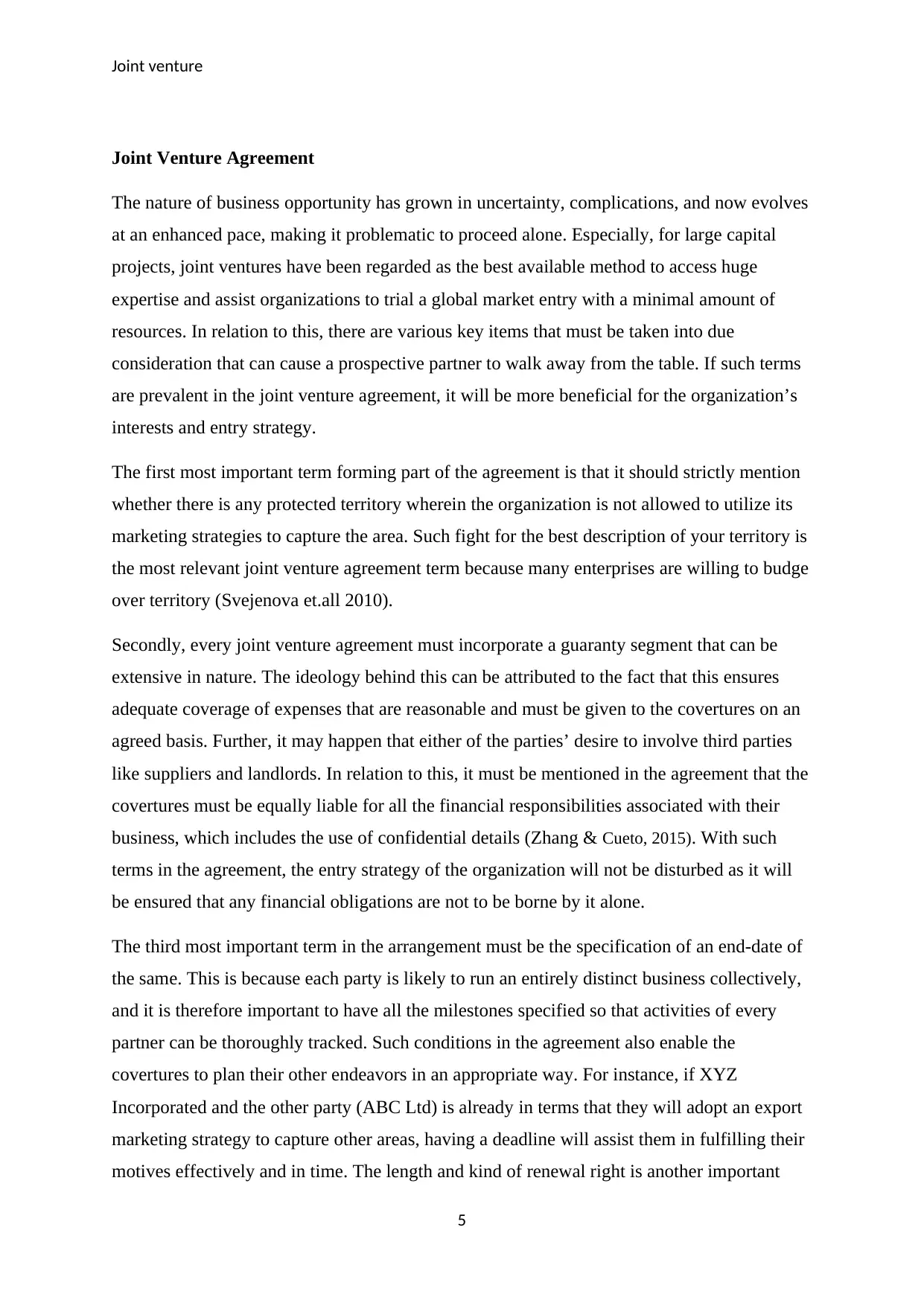
Joint venture
Joint Venture Agreement
The nature of business opportunity has grown in uncertainty, complications, and now evolves
at an enhanced pace, making it problematic to proceed alone. Especially, for large capital
projects, joint ventures have been regarded as the best available method to access huge
expertise and assist organizations to trial a global market entry with a minimal amount of
resources. In relation to this, there are various key items that must be taken into due
consideration that can cause a prospective partner to walk away from the table. If such terms
are prevalent in the joint venture agreement, it will be more beneficial for the organization’s
interests and entry strategy.
The first most important term forming part of the agreement is that it should strictly mention
whether there is any protected territory wherein the organization is not allowed to utilize its
marketing strategies to capture the area. Such fight for the best description of your territory is
the most relevant joint venture agreement term because many enterprises are willing to budge
over territory (Svejenova et.all 2010).
Secondly, every joint venture agreement must incorporate a guaranty segment that can be
extensive in nature. The ideology behind this can be attributed to the fact that this ensures
adequate coverage of expenses that are reasonable and must be given to the covertures on an
agreed basis. Further, it may happen that either of the parties’ desire to involve third parties
like suppliers and landlords. In relation to this, it must be mentioned in the agreement that the
covertures must be equally liable for all the financial responsibilities associated with their
business, which includes the use of confidential details (Zhang & Cueto, 2015). With such
terms in the agreement, the entry strategy of the organization will not be disturbed as it will
be ensured that any financial obligations are not to be borne by it alone.
The third most important term in the arrangement must be the specification of an end-date of
the same. This is because each party is likely to run an entirely distinct business collectively,
and it is therefore important to have all the milestones specified so that activities of every
partner can be thoroughly tracked. Such conditions in the agreement also enable the
covertures to plan their other endeavors in an appropriate way. For instance, if XYZ
Incorporated and the other party (ABC Ltd) is already in terms that they will adopt an export
marketing strategy to capture other areas, having a deadline will assist them in fulfilling their
motives effectively and in time. The length and kind of renewal right is another important
5
Joint Venture Agreement
The nature of business opportunity has grown in uncertainty, complications, and now evolves
at an enhanced pace, making it problematic to proceed alone. Especially, for large capital
projects, joint ventures have been regarded as the best available method to access huge
expertise and assist organizations to trial a global market entry with a minimal amount of
resources. In relation to this, there are various key items that must be taken into due
consideration that can cause a prospective partner to walk away from the table. If such terms
are prevalent in the joint venture agreement, it will be more beneficial for the organization’s
interests and entry strategy.
The first most important term forming part of the agreement is that it should strictly mention
whether there is any protected territory wherein the organization is not allowed to utilize its
marketing strategies to capture the area. Such fight for the best description of your territory is
the most relevant joint venture agreement term because many enterprises are willing to budge
over territory (Svejenova et.all 2010).
Secondly, every joint venture agreement must incorporate a guaranty segment that can be
extensive in nature. The ideology behind this can be attributed to the fact that this ensures
adequate coverage of expenses that are reasonable and must be given to the covertures on an
agreed basis. Further, it may happen that either of the parties’ desire to involve third parties
like suppliers and landlords. In relation to this, it must be mentioned in the agreement that the
covertures must be equally liable for all the financial responsibilities associated with their
business, which includes the use of confidential details (Zhang & Cueto, 2015). With such
terms in the agreement, the entry strategy of the organization will not be disturbed as it will
be ensured that any financial obligations are not to be borne by it alone.
The third most important term in the arrangement must be the specification of an end-date of
the same. This is because each party is likely to run an entirely distinct business collectively,
and it is therefore important to have all the milestones specified so that activities of every
partner can be thoroughly tracked. Such conditions in the agreement also enable the
covertures to plan their other endeavors in an appropriate way. For instance, if XYZ
Incorporated and the other party (ABC Ltd) is already in terms that they will adopt an export
marketing strategy to capture other areas, having a deadline will assist them in fulfilling their
motives effectively and in time. The length and kind of renewal right is another important
5
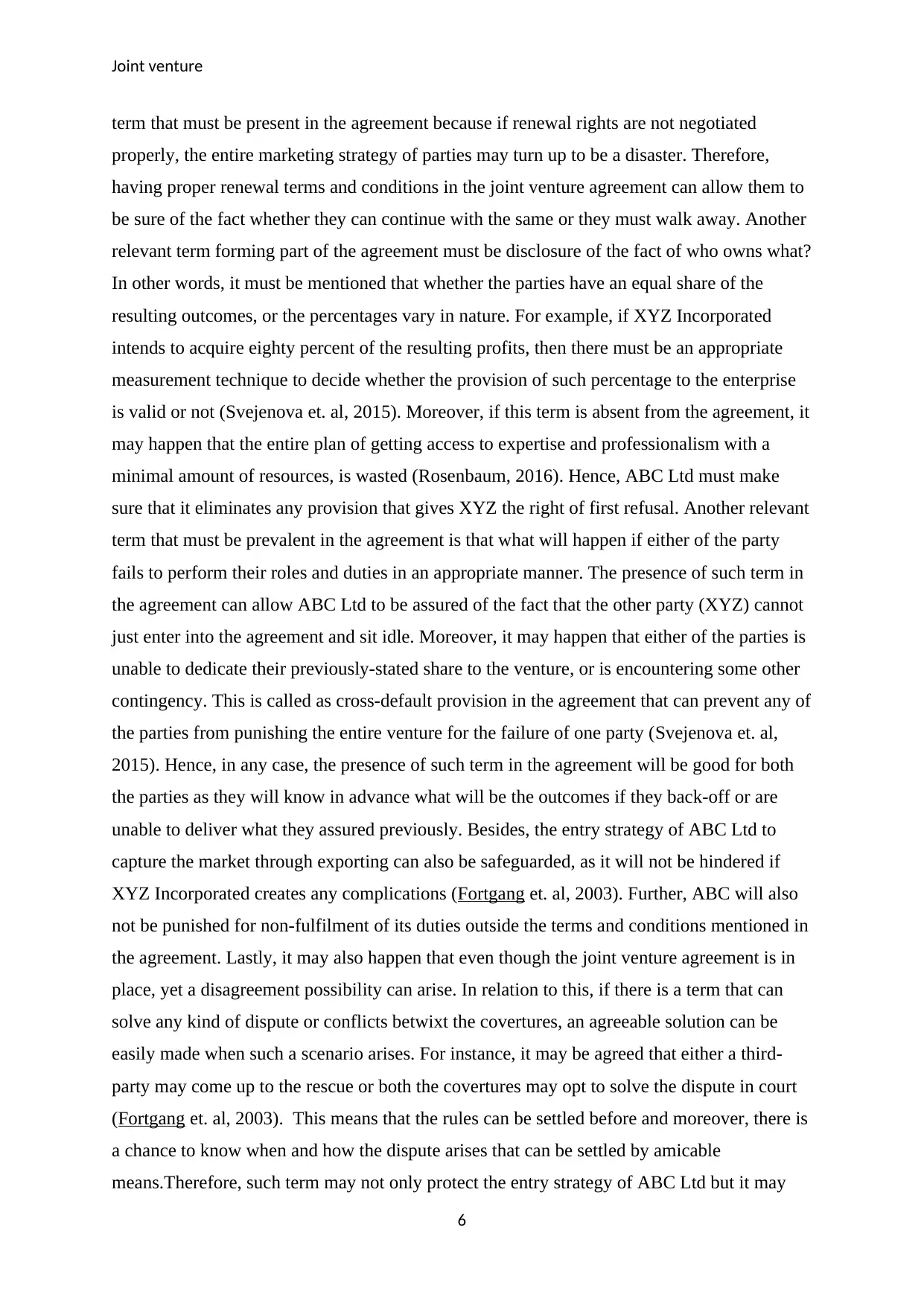
Joint venture
term that must be present in the agreement because if renewal rights are not negotiated
properly, the entire marketing strategy of parties may turn up to be a disaster. Therefore,
having proper renewal terms and conditions in the joint venture agreement can allow them to
be sure of the fact whether they can continue with the same or they must walk away. Another
relevant term forming part of the agreement must be disclosure of the fact of who owns what?
In other words, it must be mentioned that whether the parties have an equal share of the
resulting outcomes, or the percentages vary in nature. For example, if XYZ Incorporated
intends to acquire eighty percent of the resulting profits, then there must be an appropriate
measurement technique to decide whether the provision of such percentage to the enterprise
is valid or not (Svejenova et. al, 2015). Moreover, if this term is absent from the agreement, it
may happen that the entire plan of getting access to expertise and professionalism with a
minimal amount of resources, is wasted (Rosenbaum, 2016). Hence, ABC Ltd must make
sure that it eliminates any provision that gives XYZ the right of first refusal. Another relevant
term that must be prevalent in the agreement is that what will happen if either of the party
fails to perform their roles and duties in an appropriate manner. The presence of such term in
the agreement can allow ABC Ltd to be assured of the fact that the other party (XYZ) cannot
just enter into the agreement and sit idle. Moreover, it may happen that either of the parties is
unable to dedicate their previously-stated share to the venture, or is encountering some other
contingency. This is called as cross-default provision in the agreement that can prevent any of
the parties from punishing the entire venture for the failure of one party (Svejenova et. al,
2015). Hence, in any case, the presence of such term in the agreement will be good for both
the parties as they will know in advance what will be the outcomes if they back-off or are
unable to deliver what they assured previously. Besides, the entry strategy of ABC Ltd to
capture the market through exporting can also be safeguarded, as it will not be hindered if
XYZ Incorporated creates any complications (Fortgang et. al, 2003). Further, ABC will also
not be punished for non-fulfilment of its duties outside the terms and conditions mentioned in
the agreement. Lastly, it may also happen that even though the joint venture agreement is in
place, yet a disagreement possibility can arise. In relation to this, if there is a term that can
solve any kind of dispute or conflicts betwixt the covertures, an agreeable solution can be
easily made when such a scenario arises. For instance, it may be agreed that either a third-
party may come up to the rescue or both the covertures may opt to solve the dispute in court
(Fortgang et. al, 2003). This means that the rules can be settled before and moreover, there is
a chance to know when and how the dispute arises that can be settled by amicable
means.Therefore, such term may not only protect the entry strategy of ABC Ltd but it may
6
term that must be present in the agreement because if renewal rights are not negotiated
properly, the entire marketing strategy of parties may turn up to be a disaster. Therefore,
having proper renewal terms and conditions in the joint venture agreement can allow them to
be sure of the fact whether they can continue with the same or they must walk away. Another
relevant term forming part of the agreement must be disclosure of the fact of who owns what?
In other words, it must be mentioned that whether the parties have an equal share of the
resulting outcomes, or the percentages vary in nature. For example, if XYZ Incorporated
intends to acquire eighty percent of the resulting profits, then there must be an appropriate
measurement technique to decide whether the provision of such percentage to the enterprise
is valid or not (Svejenova et. al, 2015). Moreover, if this term is absent from the agreement, it
may happen that the entire plan of getting access to expertise and professionalism with a
minimal amount of resources, is wasted (Rosenbaum, 2016). Hence, ABC Ltd must make
sure that it eliminates any provision that gives XYZ the right of first refusal. Another relevant
term that must be prevalent in the agreement is that what will happen if either of the party
fails to perform their roles and duties in an appropriate manner. The presence of such term in
the agreement can allow ABC Ltd to be assured of the fact that the other party (XYZ) cannot
just enter into the agreement and sit idle. Moreover, it may happen that either of the parties is
unable to dedicate their previously-stated share to the venture, or is encountering some other
contingency. This is called as cross-default provision in the agreement that can prevent any of
the parties from punishing the entire venture for the failure of one party (Svejenova et. al,
2015). Hence, in any case, the presence of such term in the agreement will be good for both
the parties as they will know in advance what will be the outcomes if they back-off or are
unable to deliver what they assured previously. Besides, the entry strategy of ABC Ltd to
capture the market through exporting can also be safeguarded, as it will not be hindered if
XYZ Incorporated creates any complications (Fortgang et. al, 2003). Further, ABC will also
not be punished for non-fulfilment of its duties outside the terms and conditions mentioned in
the agreement. Lastly, it may also happen that even though the joint venture agreement is in
place, yet a disagreement possibility can arise. In relation to this, if there is a term that can
solve any kind of dispute or conflicts betwixt the covertures, an agreeable solution can be
easily made when such a scenario arises. For instance, it may be agreed that either a third-
party may come up to the rescue or both the covertures may opt to solve the dispute in court
(Fortgang et. al, 2003). This means that the rules can be settled before and moreover, there is
a chance to know when and how the dispute arises that can be settled by amicable
means.Therefore, such term may not only protect the entry strategy of ABC Ltd but it may
6

Joint venture
also assure it of the fact that the decision of getting into a joint venture with XYZ
Incorporated will not go in vain (Coyne & Garvin, 2013).
Therefore, these terms are the most significant terms that must form part of the joint venture
agreement because it safeguards the strategic planning of ABC Ltd and allows it to access
global markets and expertise with a very minimal amount of resources. The agreement is all
about working together, preparing to invest money and time collectively, and above all to
unleash an item for the customers that are better than what would have been facilitated
individually.
7
also assure it of the fact that the decision of getting into a joint venture with XYZ
Incorporated will not go in vain (Coyne & Garvin, 2013).
Therefore, these terms are the most significant terms that must form part of the joint venture
agreement because it safeguards the strategic planning of ABC Ltd and allows it to access
global markets and expertise with a very minimal amount of resources. The agreement is all
about working together, preparing to invest money and time collectively, and above all to
unleash an item for the customers that are better than what would have been facilitated
individually.
7
Paraphrase This Document
Need a fresh take? Get an instant paraphrase of this document with our AI Paraphraser

Joint venture
Conclusion
It can be seen from the above-mentioned analysis that commercial strategic planning can
easily assist an organization to attain its goals and objectives. Furthermore, establishing legal
relationships also play a key role in this scenario as it allows an organization to capture the
target market by framing entry strategies. Overall, all the previously mentioned legal
relationships are vital but in relation to Russia, distributor agreements consume immense time
that can cause huge losses.
8
Conclusion
It can be seen from the above-mentioned analysis that commercial strategic planning can
easily assist an organization to attain its goals and objectives. Furthermore, establishing legal
relationships also play a key role in this scenario as it allows an organization to capture the
target market by framing entry strategies. Overall, all the previously mentioned legal
relationships are vital but in relation to Russia, distributor agreements consume immense time
that can cause huge losses.
8
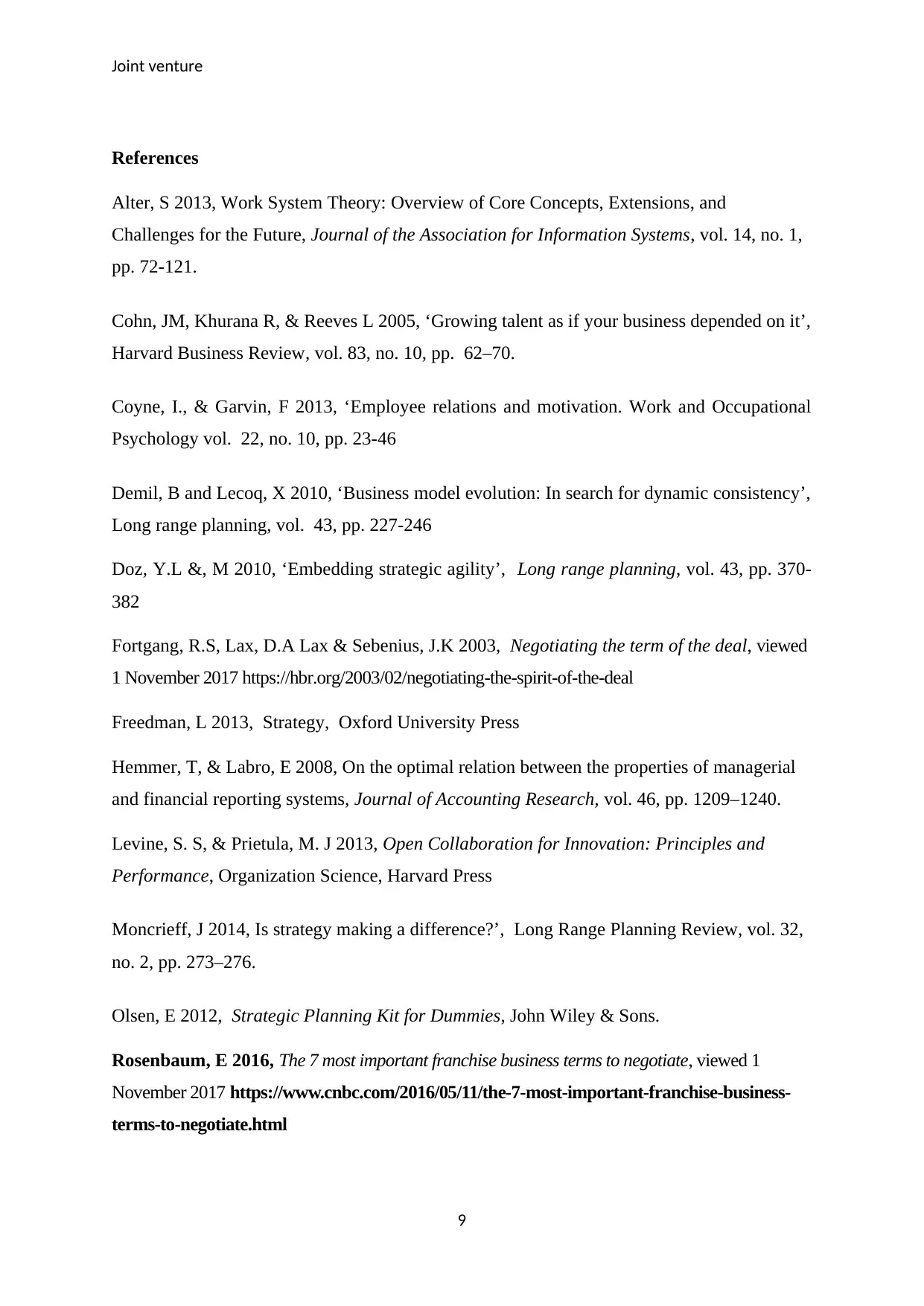
Joint venture
References
Alter, S 2013, Work System Theory: Overview of Core Concepts, Extensions, and
Challenges for the Future, Journal of the Association for Information Systems, vol. 14, no. 1,
pp. 72-121.
Cohn, JM, Khurana R, & Reeves L 2005, ‘Growing talent as if your business depended on it’,
Harvard Business Review, vol. 83, no. 10, pp. 62–70.
Coyne, I., & Garvin, F 2013, ‘Employee relations and motivation. Work and Occupational
Psychology vol. 22, no. 10, pp. 23-46
Demil, B and Lecoq, X 2010, ‘Business model evolution: In search for dynamic consistency’,
Long range planning, vol. 43, pp. 227-246
Doz, Y.L &, M 2010, ‘Embedding strategic agility’, Long range planning, vol. 43, pp. 370-
382
Fortgang, R.S, Lax, D.A Lax & Sebenius, J.K 2003, Negotiating the term of the deal, viewed
1 November 2017 https://hbr.org/2003/02/negotiating-the-spirit-of-the-deal
Freedman, L 2013, Strategy, Oxford University Press
Hemmer, T, & Labro, E 2008, On the optimal relation between the properties of managerial
and financial reporting systems, Journal of Accounting Research, vol. 46, pp. 1209–1240.
Levine, S. S, & Prietula, M. J 2013, Open Collaboration for Innovation: Principles and
Performance, Organization Science, Harvard Press
Moncrieff, J 2014, Is strategy making a difference?’, Long Range Planning Review, vol. 32,
no. 2, pp. 273–276.
Olsen, E 2012, Strategic Planning Kit for Dummies, John Wiley & Sons.
Rosenbaum, E 2016, The 7 most important franchise business terms to negotiate, viewed 1
November 2017 https://www.cnbc.com/2016/05/11/the-7-most-important-franchise-business-
terms-to-negotiate.html
9
References
Alter, S 2013, Work System Theory: Overview of Core Concepts, Extensions, and
Challenges for the Future, Journal of the Association for Information Systems, vol. 14, no. 1,
pp. 72-121.
Cohn, JM, Khurana R, & Reeves L 2005, ‘Growing talent as if your business depended on it’,
Harvard Business Review, vol. 83, no. 10, pp. 62–70.
Coyne, I., & Garvin, F 2013, ‘Employee relations and motivation. Work and Occupational
Psychology vol. 22, no. 10, pp. 23-46
Demil, B and Lecoq, X 2010, ‘Business model evolution: In search for dynamic consistency’,
Long range planning, vol. 43, pp. 227-246
Doz, Y.L &, M 2010, ‘Embedding strategic agility’, Long range planning, vol. 43, pp. 370-
382
Fortgang, R.S, Lax, D.A Lax & Sebenius, J.K 2003, Negotiating the term of the deal, viewed
1 November 2017 https://hbr.org/2003/02/negotiating-the-spirit-of-the-deal
Freedman, L 2013, Strategy, Oxford University Press
Hemmer, T, & Labro, E 2008, On the optimal relation between the properties of managerial
and financial reporting systems, Journal of Accounting Research, vol. 46, pp. 1209–1240.
Levine, S. S, & Prietula, M. J 2013, Open Collaboration for Innovation: Principles and
Performance, Organization Science, Harvard Press
Moncrieff, J 2014, Is strategy making a difference?’, Long Range Planning Review, vol. 32,
no. 2, pp. 273–276.
Olsen, E 2012, Strategic Planning Kit for Dummies, John Wiley & Sons.
Rosenbaum, E 2016, The 7 most important franchise business terms to negotiate, viewed 1
November 2017 https://www.cnbc.com/2016/05/11/the-7-most-important-franchise-business-
terms-to-negotiate.html
9

Joint venture
Smith, W.K., Binns, A and Tushman, M.L 2010, ‘Complex business models: Managing
strategic paradoxes simultaneously’, Long range planning, vol. 43, pp. 448-461
Svejenova, S., Planellas, M and Vives, L 2010, ‘An individual business model in the making:
Achef’s quest for creative freedom’, Long range planning, vol. 43, pp. 408-430
Zhang, S.X. & Cueto, J 2015, The Study of Bias in Entrepreneurship, Entrepreneurship
Theory and Practice.
10
Smith, W.K., Binns, A and Tushman, M.L 2010, ‘Complex business models: Managing
strategic paradoxes simultaneously’, Long range planning, vol. 43, pp. 448-461
Svejenova, S., Planellas, M and Vives, L 2010, ‘An individual business model in the making:
Achef’s quest for creative freedom’, Long range planning, vol. 43, pp. 408-430
Zhang, S.X. & Cueto, J 2015, The Study of Bias in Entrepreneurship, Entrepreneurship
Theory and Practice.
10
1 out of 10
Your All-in-One AI-Powered Toolkit for Academic Success.
+13062052269
info@desklib.com
Available 24*7 on WhatsApp / Email
![[object Object]](/_next/static/media/star-bottom.7253800d.svg)
Unlock your academic potential
© 2024 | Zucol Services PVT LTD | All rights reserved.



